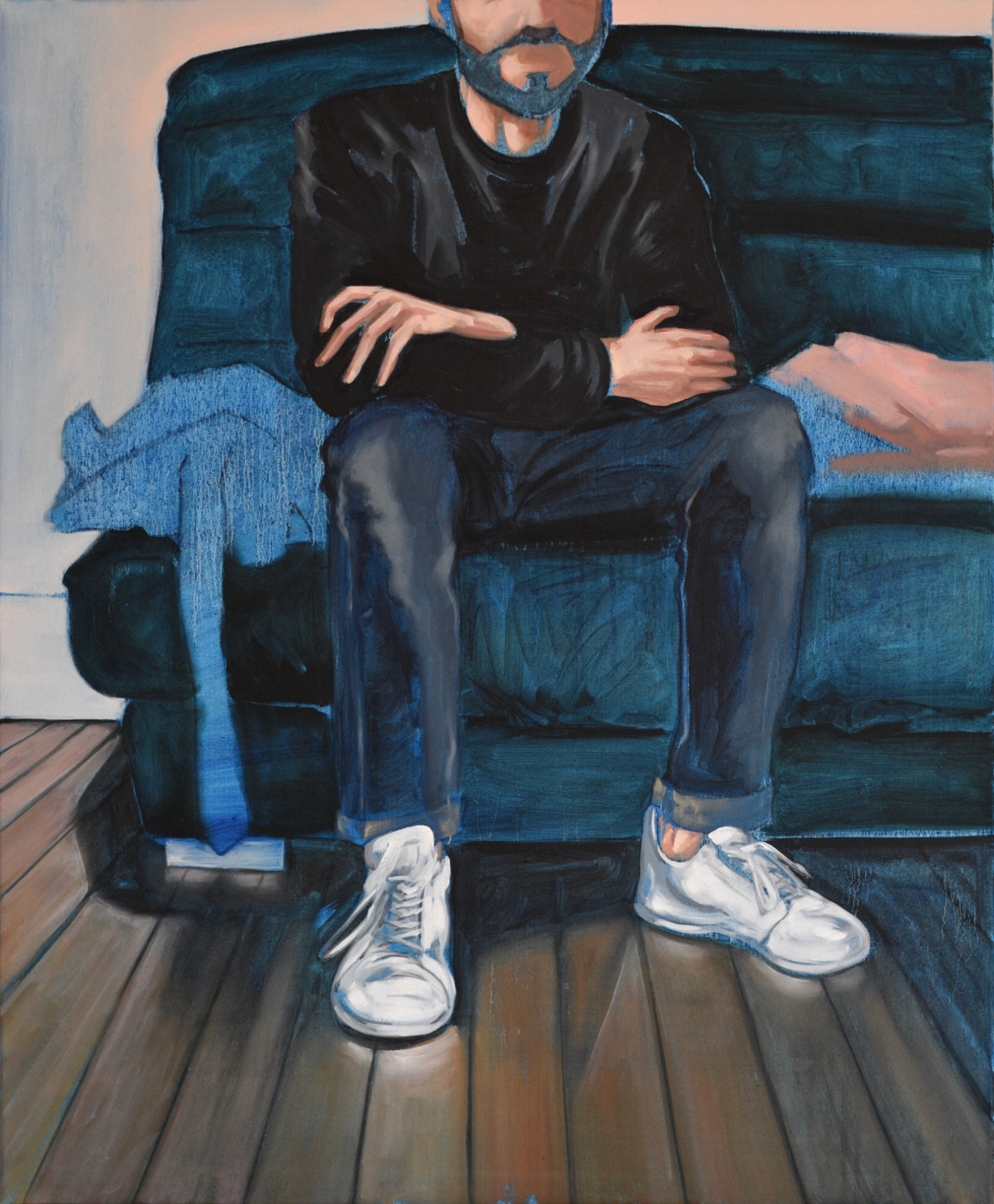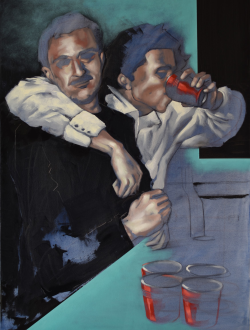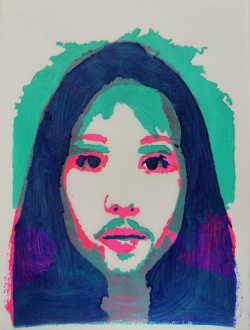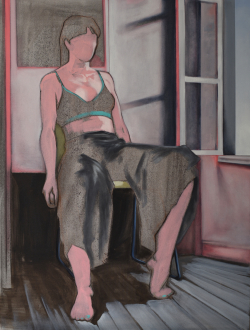
Face-iD
Eder Olguìn
A cura di ILARIA MONTI
Intro Ilaria Monti.
S’inventò un volto.
Dietro di esso,
molte volte
visse, morì e risuscitò.
Oggi
il suo volto ha le rughe di quel volto.
Le sue rughe non hanno volto.
(Octavio Paz)
Face-iD
Eder Olguìn
A cura di ILARIA MONTI
Intro Ilaria Monti.
S’inventò un volto.
Dietro di esso,
molte volte
visse, morì e risuscitò.
Oggi
il suo volto ha le rughe di quel volto.
Le sue rughe non hanno volto.
(Octavio Paz)
Per Eder Olguìn la pittura è un esercizio di memoria e insieme un destino di dimenticanza. L’artista evoca un tempo passato, ne distorce i ricordi, interroga il presente. Nel tempo della pittura, si dirama una geografia costellata di luoghi intimamente connessi all’esperienza personale. I confini temporali e spaziali sfumano e scolorano nelle presenze che come sagome abitano i dipinti e la vita dell’artista.
Le opere in mostra, realizzate a partire dal 2020, seppur appartenenti a diverse stagioni della produzione pittorica, nascono tutte da un’esigenza comune, quella di ritrovarsi nell’immagine dell’altro. In particolare, i volti sono sottoposti ad un’operazione di rimozione e sintesi con cui l’artista cela l’identità dei soggetti. Concentrandosi su questi volti vuoti, il titolo della mostra Face ID richiama paradossalmente il sistema di riconoscimento facciale sviluppato negli ultimi anni per i più recenti smartphone: un algoritmo matematico in grado di mappare, riconoscere e ricordare i tratti del nostro viso. Non a caso, la fotografia rappresenta per l’artista uno strumento necessario all’astrazione del ricordo e alla costruzione di un personale archivio visivo, tanto da costituire spesso il punto di partenza dell’opera. L’artista utilizza fotografie conservate negli album di famiglia o scattate più recentemente in occasioni significative o in momenti quotidiani. Alcune delle foto recuperate custodiscono ricordi d’infanzia: l’estate del ’97 in Messico con la famiglia, momenti di gioco col fratello, i vicini di casa da bambini; altre ancora lo vedono cresciuto, immortalano il giorno del suo trasloco da uno degli appartamenti parigini in cui ha vissuto. Le fotografie funzionano come matrici dell’opera, sono ingranaggi della trans-figurazione che avviene nei colori vividi e saturi della pittura. La realtà scontorna, mentre persone reali diventano personaggi senza volto nel teatro della memoria. I soggetti ritratti, con la loro fisionomia sfumata, sembrano sospesi in uno spazio spesso indefinito e metafisico, vestiti di un’atmosfera nostalgica e sospesa. Cancellando quasi completamente i tratti del viso Eder priva lo spettatore, chiunque esso o essa sia, della possibilità di riconoscimento dell’altro, rendendo invece possibile il riconoscimento nell’altro: siamo stati quei bambini che Eder ha dipinto, quei ragazzi che bevono al bancone di un bar. Siamo stati quella giovane donna seduta vicino alla finestra, siamo stati seduti per l’ultima volta sul divano di un appartamento in cui non saremmo più entrati.
È proprio a partire dalla sovrapposizione e dalla condivisione di esperienze diverse che Eder Olguìn ha concepito il suo ultimo lavoro, tutt’ora in corso. L’artista presenta per la prima volta una selezione di opere dalla serie Identité conforme, che prevede la realizzazione di 2730 ritratti. Ciascun ritratto della serie è il risultato della combinazione di cinque fototessere appartenenti a persone care all’artista, e che hanno tutte provenienze e radici diverse. Come superfici semitrasparenti, l’artista crea una stratificazione di volti: quello di Ines, franco-argentina, di Veronica, franco-italiana, di Aline, franco-vietnamita, di Youssef, marocchino, e infine di sé stesso, messicano, parigino d’adozione, formatosi in Italia e libico da parte di madre. Il lavoro prende le mosse da una riflessione sulla propria identità e sul proprio stato di immigrato in Europa, nonché dalla necessità di un permesso di soggiorno, e si configura come un mèlange di tratti somatici e coordinate geografiche. Nella mescolanza Eder inventa nuovi volti, nuove identità. L’utilizzo di piccole fototessere, infatti, allude all’identificazione e alla riconoscibilità necessaria nei documenti di identità e nei passaporti.
Ogni viso ha una sua grammatica, un suo modo di significare e manifestarsi attraverso i segni sulla pelle, negli occhi, sulle labbra, tra la fronte e il mento. Una grammatica che ci racconta all’altro e che ci permette di essere visti e riconosciuti. Velato, cancellato, alterato o moltiplicato, il viso diventa allora una storia illeggibile, un segreto, un mistero. I ritratti di Eder sono sospesi nella polarità tra il realismo e la verità dell’immagine fotografica e la sua rielaborazione pittorica, in una zona liminale come quella individuata dal sociologo e filosofo berlinese George Simmel nelle sue riflessioni di estetica e sociologia raccolte in Il volto e il ritratto. Saggi sull’arte (1985). Scriveva Simmel: «[…] ciò che noi vediamo nell’uomo è ciò che è durevole in lui; nel suo viso è disegnata, come in una sezione attraverso gli strati geologici, la storia della sua vita». Mentre il pensiero contemporaneo ha tematizzato il volto da un punto di vista antropologico, estetico, filosofico, politico e religioso, nel campo dell’arte visiva contemporanea esso diventa oggetto non soltanto della raffigurazione, ma di un processo di rifigurazione: non solo e non più simulacro, effigie o ritratto per la conservazione della memoria, ma campo aperto all’indagine e al rinnovamento dell’identità e alla manipolazione del ricordo. Così nelle opere di Eder Olguìn l’immagine si compie in una sintesi visiva fugace e lacunosa, in cui il riconoscimento è sempre solamente un’ipotesi. Un volto, tra i tanti possibili.
Eder Olguìn
(1989, Puebla, Messico) vive e lavora a Parigi.
Si forma in pittura e discipline plastiche tra l’Accademia di Belle Arti di Napoli e La Sorbonne di Parigi.Tra le mostre personali: Lucha, Galerie Beausoleil, Parigi (2022); 2×1, DISPLAY, Parma (2021); Eder Olguìn e Damiano Azzizia, Still, Relevo Arts online platform (2020); Onirismos, Puebla, Messico (2020). Tra le mostre collettive: Meta_Fair#2, Moving with_in the complex: independent curating, co_atto, Milano, IT (2022); Traverser Latitudes: Artistes contemporains d’Amérique Latine, 59 Rivoli, Parigi; Expo Vitale, les rivoliens anonimes,59 Rivoli. Parigi; Artistas poblanos en Oaxaca – Direction d’art et culture, Université Autonome de Oxaca, Messico (2020); Al final de la jornada, Union de artes plasticas de Puebla A.C. Barrio del artista, Puebla, Messico; Entre lineas y sombras, Union de artes plasticas de Puebla A.C. Barrio del artista, Puebla, Messico; XIII salon del desnudo, Union de artes plasticas de Puebla A.C. Barrio del artista, Puebla, Messico (2019).
English version
He invented a face for himself.
Behind it, he lived, died,
and was resurrected many times.
Today his face
has the wrinkles of that face.
His wrinkles have no face
(Octavio Paz)
For Eder Olguìn, painting is both an exercise in memory and a fate of forgetfulness. The artist evokes a past time, distorts its memories, interrogates the present; in the time of painting, a personal geography takes shape. Temporal and spatial boundaries fade into the figures-like-silhouettes presences living both in the paintings and in the life of the artist.
The selected works have been realized since 2020, and although belonging to different periods of Olguìn’s production, they are all born out of a common need: finding oneself in the image of the other. In particular, the artist deprives subjects’ faces of their distinctive features and synthesizes the figures veiling their identity. Focusing on these empty faces, the title of the exhibition Face ID paradoxically recalls the facial recognition system developed in recent years for the latest smartphones: a mathematical algorithm capable of mapping, recognizing and remembering our facial features. It is no coincidence that Eder Olguìn often uses photography as the starting point of his work, since it represents an essential tool to abstract memories and create a personal visual archive. The artist makes use of old photographs from his family albums or from recent shots which capture significant occasions or daily life episodes. Some of the photos behind the works relate to his childhood memories: the summer of ’97 in Mexico with his family, playtime moments with his brother, some neighbors as children; in other photos the artist is grown up, caught while sitting in his Parisian apartment before moving out. The photographs serve as matrices of the work, they activate a transfiguration process which takes place in the vivid and saturated colors of painting. Reality crops out, while real people become faceless characters in the theater of memory. The portrayed subjects, with their blurred physiognomy, are suspended in a vague and metaphysical space, dressed with a nostalgic and suspended atmosphere. By almost completely erasing facial features, Eder Olguìn prevents the viewers from recognizing the other, instead making it possible to recognize themselves in the other: we have been those children that Eder has painted, those boys drinking at bar counter. We have been that girl sitting by the window, and we have been seated for the last time on the couch of a house we would never enter again.
It is precisely on the basis of the overlapping and sharing different experiences that Eder Olguìn has conceived his latest ongoing work. The artist presents for the first time a body of works from the series Identité conforme, which involves the creation of 2730 portraits. Each portrait is the result of the combination of five passport photos belonging to the artist’s beloved ones, who all come from different countries. The artist creates a layering of their faces, as if they were semitransparent surfaces: that of Ines, French-Argentinean, of Veronica, French-Italian, of Aline, French-Vietnamese, of Youssef, Moroccan, and finally his own face – Eder is Mexican, Parisian from adoption, with an Italian education and with lybian roots on his mother’s side. The series, taking its cue from a reflection on the artist’s identity and status as an immigrant in Europe, is configured as a mèlange of somatic features and geographical coordinates. By blending five faces Eder invents thousands of new identities. The use of small passport photos, in fact, alludes recognizability needed in identity documents.
Each face has its own grammar, its own way of signifying and expressing itself through the marks on the skin, the eyes, the lips, the space between the forehead and the chin. This somatic grammar allows us to be seen and recognized. Once the face has been veiled, erased, altered or multiplied, it becomes an unreadable story, a secret, a mystery. Eder’s portraits float between the realism and truth of the photographic image and its painterly reworking, in a borderland such as that identified by the German sociologist and philosopher George Simmel in his aesthetics and sociological studies collected in The face and the portrait. Essays on art (1985). Simmel wrote that what we see in man is what is durable in him; in his face is drawn, as a cross section through geological layers, the history of his life. While contemporary thought has thematized the face from an anthropological, aesthetic, philosophical, political and religious point of view, in the field of contemporary visual arts it is not only represented, but refigured: no longer a simulacrum, an effigy or a portrait for the preservation of someone’s memory, but a land to be investigated, a surface where identity can be reshaped and memory itself can be manipulated. Thus, in Olguìn’s works the image is fulfilled in a fleeting and fragmentary synthesis, in which the act of recognition is a pure hypothesis. It is just one face, among the many possible ones.
Eder Olguìn
(b. 1989, Puebla, Mexico) lives and works in Paris.
He studied Painting and Plastic Disciplines between the Academy of Fine Arts in Naples and the Sorbonne in Paris. Selected solo exhibitions: Lucha, Galerie Beausoleil, Paris (2022); 2×1, DISPLAY, Parma (2021); Still, with Damiano Azzizia, Relevo Arts online platform (2020); Onirismos, Puebla, Mexico (2020). Selected group exhibitions: Meta_Fair#2, Moving with_in the complex: independent curating, co_atto, Milan, IT (2022); Traverser Latitudes: Artistes contemporains d’Amérique Latine, 59 Rivoli, Paris; Expo Vitale, les rivoliens anonymous, 59 Rivoli. Paris; Artistas poblanos en Oaxaca – Direction d’art et culture, Université Autonome de Oxaca, Mexico (2020); At the end of the day, Union de artes plasticas de Puebla A.C. Barrio del Artista, Puebla, Mexico; Entre lineas y sombras, Union de artes plasticas de Puebla A.C. Barrio del Artista, Puebla, Mexico; XIII salon del desnudo, Union de artes plasticas de Puebla A.C. Artist’s Quarter, Puebla, Mexico (2019).



